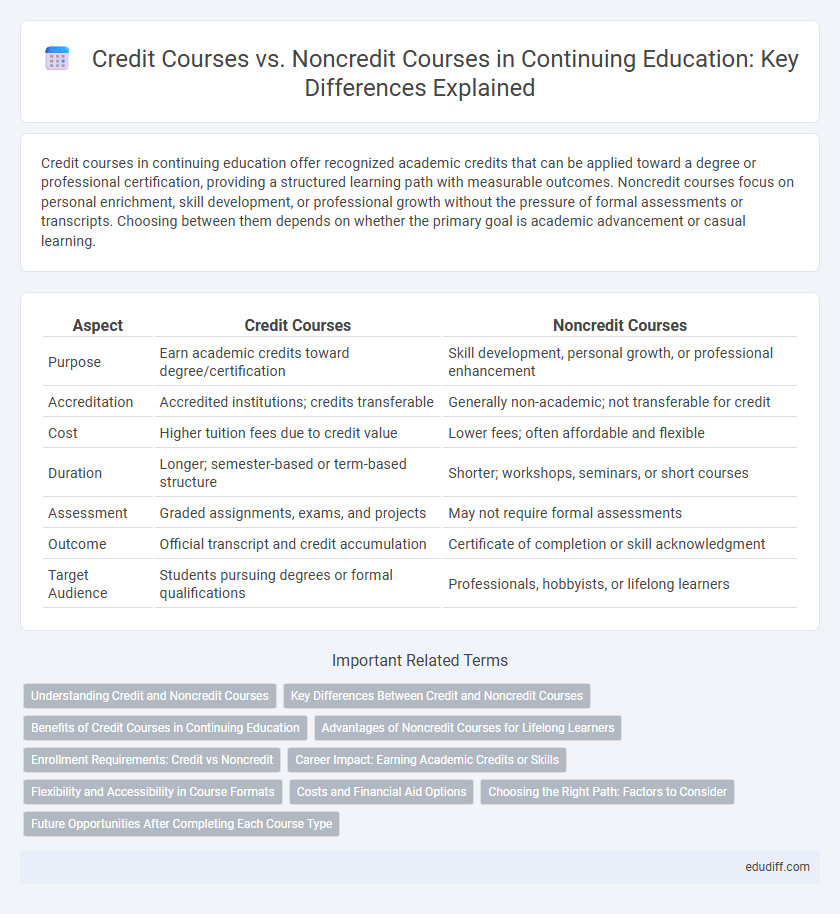Credit courses in continuing education offer recognized academic credits that can be applied toward a degree or professional certification, providing a structured learning path with measurable outcomes. Noncredit courses focus on personal enrichment, skill development, or professional growth without the pressure of formal assessments or transcripts. Choosing between them depends on whether the primary goal is academic advancement or casual learning.
Table of Comparison
| Aspect | Credit Courses | Noncredit Courses |
|---|---|---|
| Purpose | Earn academic credits toward degree/certification | Skill development, personal growth, or professional enhancement |
| Accreditation | Accredited institutions; credits transferable | Generally non-academic; not transferable for credit |
| Cost | Higher tuition fees due to credit value | Lower fees; often affordable and flexible |
| Duration | Longer; semester-based or term-based structure | Shorter; workshops, seminars, or short courses |
| Assessment | Graded assignments, exams, and projects | May not require formal assessments |
| Outcome | Official transcript and credit accumulation | Certificate of completion or skill acknowledgment |
| Target Audience | Students pursuing degrees or formal qualifications | Professionals, hobbyists, or lifelong learners |
Understanding Credit and Noncredit Courses
Credit courses offer academic credits that contribute toward a degree or certification, impacting GPA and fulfilling graduation requirements. Noncredit courses focus on skill development, personal enrichment, or professional training without awarding academic credits or affecting GPA. Understanding the distinction helps students align their educational goals with course offerings and institutional policies.
Key Differences Between Credit and Noncredit Courses
Credit courses contribute to degree requirements and typically follow a structured curriculum with formal assessments, earning students transferable credits recognized by academic institutions. Noncredit courses focus on skill development, personal enrichment, or professional training without awarding academic credits, often providing flexible schedules and shorter durations. The primary difference lies in the credentialing value and transferability of credits, impacting academic progression and career advancement opportunities.
Benefits of Credit Courses in Continuing Education
Credit courses in continuing education provide recognized academic credits that can be transferred toward degree programs, enhancing career advancement opportunities. These courses often follow rigorous curricula designed to deepen subject mastery and improve professional qualifications. Earning credit reduces the time and cost required to complete higher education credentials compared to noncredit options.
Advantages of Noncredit Courses for Lifelong Learners
Noncredit courses offer lifelong learners flexible schedules and diverse subject options without the pressure of grades, making them ideal for personal enrichment and skill development. These courses often have lower tuition costs and no prerequisite requirements, enabling easy access to education at any stage of life. Noncredit learning enhances professional growth and cognitive health while fostering a sense of community among adult learners.
Enrollment Requirements: Credit vs Noncredit
Enrollment requirements for credit courses typically include prerequisites such as prior coursework, placement tests, or transcripts to ensure student readiness. Noncredit courses generally have open enrollment policies with minimal or no prerequisites, allowing broader access for lifelong learners or professional development. This flexibility makes noncredit programs ideal for individuals seeking skill enhancement without the formal admission criteria of credit-bearing classes.
Career Impact: Earning Academic Credits or Skills
Credit courses offer the advantage of earning academic credits that contribute directly to degree completion, making them essential for career advancement in fields requiring formal qualifications. Noncredit courses focus on skill development and professional growth without affecting academic transcripts, ideal for individuals seeking immediate skill enhancement or career shifts. Choosing between credit and noncredit options depends on whether the goal is to obtain formal credentials or to gain practical skills for job performance.
Flexibility and Accessibility in Course Formats
Credit courses often offer structured schedules with fixed deadlines, providing clear pathways toward degree completion, while noncredit courses frequently emphasize flexibility with self-paced formats and varied start dates. Online and hybrid options expand accessibility for both credit and noncredit offerings, accommodating diverse learner needs including working professionals and adult learners. Institutions increasingly leverage digital platforms to enhance course availability, enabling learners to balance education with personal and professional commitments effectively.
Costs and Financial Aid Options
Credit courses generally have higher tuition fees compared to noncredit courses, reflecting their role in degree programs and transfer credits. Financial aid options such as federal grants, scholarships, and student loans are extensively available for credit courses but are typically limited or unavailable for noncredit courses. Some institutions may offer payment plans or employer reimbursement programs to help offset the costs of noncredit courses.
Choosing the Right Path: Factors to Consider
Selecting between credit courses and noncredit courses hinges on your academic goals, budget, and timeline. Credit courses provide recognized qualifications essential for degree progression and career advancement, often requiring higher tuition fees and a commitment to rigorous assessments. Noncredit courses offer flexibility and skill development without the pressure of grades or credit accumulation, ideal for personal enrichment or specific professional skills enhancement.
Future Opportunities After Completing Each Course Type
Credit courses often lead to transferable college credits that enhance academic credentials and open pathways to advanced degrees and professional certifications. Noncredit courses primarily improve practical skills and personal development, which can boost employability and career advancement in specific industries without formal academic recognition. Completing credit courses generally offers broader future educational opportunities, while noncredit courses provide immediate, skill-based benefits tailored to workforce demands.
Credit Courses vs Noncredit Courses Infographic

 edudiff.com
edudiff.com